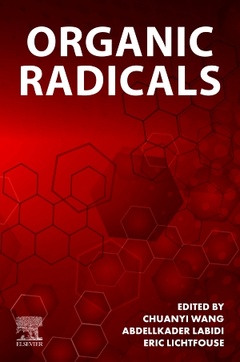Organic Radicals
Coordonnateurs : Wang Chuanyi, Labidi Abdellkader, Lichtfouse Eric

Organic Radicals summarizes the applications of these materials in several fields, in addition to analyzing challenges, limitations and impacts of materials containing organic radicals on human, plants, water, soil, and animals. Sections cover uses of organic radicals as effective precursors for block molecules building and discuss their effectiveness as precursors of organic radical- containing materials synthesis and their applications in medicine, biology, electronics, environmental sciences, plastics synthesis, polymers building and the several impacts after organic radicals uses. In recent years, the rapid development of organic radical-containing materials has afforded an interesting research area in various applications.
2. Biodegradability, life cycle analysis and biocompatibility of organic radicals
3. Toxicity of organic radicals for humans, plants, soils and other living organisms
4. Fundamental characteristics of organicradicals used in biomedical applications
5. Biological aspects of organic radical-containing materials
6. Synthesis and characterization of radical-based magnetic and magnetophotonic materials using organic free radicals
7. Organic radicals containing materials with optoelectronic properties
8. Photocatalyst materials formed using organic radicals for water splitting
9. Organic radicals with catalytic activities in organic chemistry
10. Polymeric materials synthesis with organic radicals employed to fabricate industrial materials
11. Materials based on organic radicals used in electrochemical application
12. Nanocomposites synthesis with organic radicals for the organic and inorganic pollutants removal
13. Organic radicals containing-materials used to fabricate film packaging
14. Materials based on organic radicals for gases capture
15. Organic radicals used to modify materials surface and their application to remove pharmaceutical residues
16. Nano- and micro-plastics removal using organic radicals-based materials
17. Materials functionalization with organic radicals used for soil treatment
18. Organic radicals used in conducting polymers synthesis
https://www.scopus.com/authid/detail.uri?authorId=55796485900
Abdellkader Labidi obtained his first degree from University of Sciences of Tunis and stayed there to complete his PhD in 2017 under the supervision of Prof. Manef Abderrabba. In 2018, he joined the team of his thesis ‘supervisor as a research scholar in the Laboratory of Materials, Molecules and Applications, IPEST, Preparatory Institute of Scientific and Technical Studies of Tunis, University of Carthage, La Marsa, Tunisia. During four years, he worked as a supervisor of master students and he has an experience of teaching at the Private University of Tunis in 2019. He is now carrying out his postdoctoral research under the supervision of Prof. Ch
- Covers the main proprieties and current techniques in organic radicals’ measurements, advantages, and disadvantages
- Analyzes the lifecycle analysis and the stability of organic radicals, their biodegradability, and biocompatibility
- Provides a comprehensive overview about the chemical synthesis of organic radicals, their physiochemical proprieties, and risks caused by the presence of high amounts of organic radicals
Date de parution : 03-2024
Ouvrage de 446 p.
15x22.8 cm
Thème d’Organic Radicals :
Mots-clés :
Organic radicals; Molecular engineering; Macromolecules design; Catalysis



